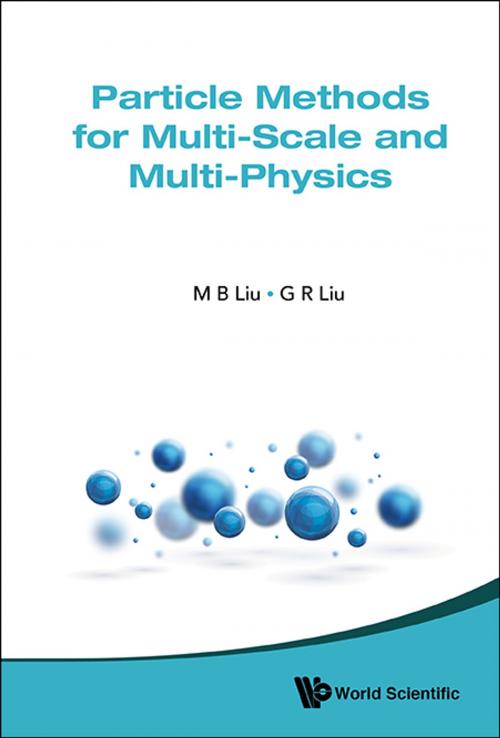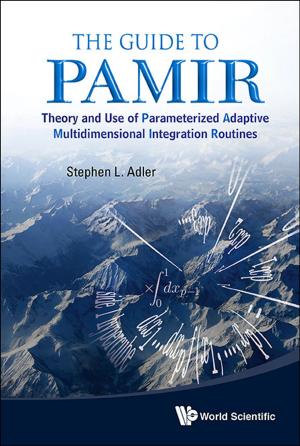Particle Methods for Multi-Scale and Multi-Physics
Nonfiction, Science & Nature, Mathematics, Applied| Author: | M B Liu, G R Liu | ISBN: | 9789814571715 |
| Publisher: | World Scientific Publishing Company | Publication: | December 28, 2015 |
| Imprint: | WSPC | Language: | English |
| Author: | M B Liu, G R Liu |
| ISBN: | 9789814571715 |
| Publisher: | World Scientific Publishing Company |
| Publication: | December 28, 2015 |
| Imprint: | WSPC |
| Language: | English |
Multi-scale and multi-physics modeling is useful and important for all areas in engineering and sciences. Particle Methods for Multi-Scale and Multi-Physics systematically addresses some major particle methods for modeling multi-scale and multi-physical problems in engineering and sciences. It contains different particle methods from atomistic scales to continuum scales, with emphasis on molecular dynamics (MD), dissipative particle dynamics (DPD) and smoothed particle hydrodynamics (SPH).
This book covers the theoretical background, numerical techniques and many interesting applications of the particle methods discussed in this text, especially in: micro-fluidics and bio-fluidics (e.g., micro drop dynamics, movement and suspension of macro-molecules, cell deformation and migration); environmental and geophysical flows (e.g., saturated and unsaturated flows in porous media and fractures); and free surface flows with possible interacting solid objects (e.g., wave impact, liquid sloshing, water entry and exit, oil spill and boom movement). The presented methodologies, techniques and example applications will benefit students, researchers and professionals in computational engineering and sciences.
Contents:
- Introduction
- Molecular Dynamics
- Dissipative Particle Dynamics — Methodology
- Dissipative Particle Dynamics — Applications
- Smoothed Particle Hydrodynamics — Methodology
- Smoothed Particle Hydrodynamics — Applications
- Three Typical Particle Methods
Readership: Undergraduates, graduates, researchers, and professionals studying/dealing with fluid mechanics, numerical analysis and computational mathematics, engineering mechanics, ocean engineering, mechanical engineering.
Key Features:
- The authors have many years of experience in meshfree and particle methods, and are renowned scientists in related areas, with highly cited publications. This can greatly attracts fellow researchers from all around the world to probe the latest development on current major particle methods
- The authors have authored numerous technical publications, and many popular books. They truly understand what the fellow researchers think and want
- The authors have extensive network in academics and research. It is comparatively easy to introduce the book to professional organizations, international conferences, and different academic bodies such as universities and research institutes
Multi-scale and multi-physics modeling is useful and important for all areas in engineering and sciences. Particle Methods for Multi-Scale and Multi-Physics systematically addresses some major particle methods for modeling multi-scale and multi-physical problems in engineering and sciences. It contains different particle methods from atomistic scales to continuum scales, with emphasis on molecular dynamics (MD), dissipative particle dynamics (DPD) and smoothed particle hydrodynamics (SPH).
This book covers the theoretical background, numerical techniques and many interesting applications of the particle methods discussed in this text, especially in: micro-fluidics and bio-fluidics (e.g., micro drop dynamics, movement and suspension of macro-molecules, cell deformation and migration); environmental and geophysical flows (e.g., saturated and unsaturated flows in porous media and fractures); and free surface flows with possible interacting solid objects (e.g., wave impact, liquid sloshing, water entry and exit, oil spill and boom movement). The presented methodologies, techniques and example applications will benefit students, researchers and professionals in computational engineering and sciences.
Contents:
- Introduction
- Molecular Dynamics
- Dissipative Particle Dynamics — Methodology
- Dissipative Particle Dynamics — Applications
- Smoothed Particle Hydrodynamics — Methodology
- Smoothed Particle Hydrodynamics — Applications
- Three Typical Particle Methods
Readership: Undergraduates, graduates, researchers, and professionals studying/dealing with fluid mechanics, numerical analysis and computational mathematics, engineering mechanics, ocean engineering, mechanical engineering.
Key Features:
- The authors have many years of experience in meshfree and particle methods, and are renowned scientists in related areas, with highly cited publications. This can greatly attracts fellow researchers from all around the world to probe the latest development on current major particle methods
- The authors have authored numerous technical publications, and many popular books. They truly understand what the fellow researchers think and want
- The authors have extensive network in academics and research. It is comparatively easy to introduce the book to professional organizations, international conferences, and different academic bodies such as universities and research institutes















